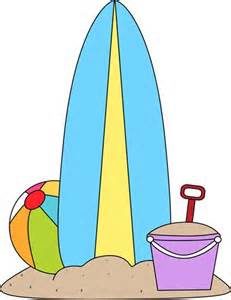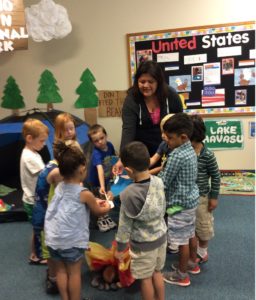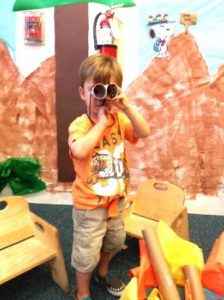Hello Summer!

We are Splishin’ and Splashin’ into a Summer full of fun and exploration at Discovery Isle!
Message from the Principal
Come along on our All-American Road Trip… beep beep! Tons of Learning and fun straight ahead as the children explore maps, as well as a variety of states during the month or July. In August, the children will continue on their summer adventure, this time by airplane! Our annual imaginary trip will be to South America! Children will learn about a variety of countries and cultures in South America, as well as celebrating Rio Brazil for the Summer Olympics!
News from the Education Department
Enter the World of Imaginative Play
Think of the last time your child pretended that a paper towel roll was a magic wand, or put on a hat and became a cowboy. Young children are naturally wired to learn through imaginative play. Sometimes, imaginative play may appear to be just idle time, unstructured or less productive than educational activities such as music lessons, dance class, or karate. Yet, it is through imaginative play experiences that children make sense of the world, establish important self-regulation skills, and process academic content at a higher level.
Below are some ways that we encourage imaginative play in the classroom and some ideas to try at home.
Provide time for unstructured play. In our classrooms, we give students the opportunity to choose from various structured learning activities, while also allowing time for imaginative play. During circle time, for example, children may become very interested in a story about farm life. The teachers then allow them to go outside, create their own “farm” in the sandbox using props, and pretend to be farmers. Through this activity, children develop cognitive skills such as sustained attention, problem solving and sequential memory. At home, you can make up an indoor campsite with your child using sleeping bags, pillows, toy food, cooking utensils and pots. Ask your child “What should we make for dinner?” or “What games do you want to play while we camp?”
Give children a variety of materials so they can make their own props. In our classrooms, students use cardboard boxes and art supplies to create pirate ships and castles. Some students may create a kitchen out of boxes and pretend to be chefs in their own restaurant. They practice writing skills by creating a menu, and use culinary-themed vocabulary to communicate with their restaurant patrons. By participating in this activity, students practice taking turns, sharing and listening to others. Give your child art supplies and a box at home and see their imagination run wild. Let your child’s interests lead and shape the play.
Engage in imaginative play, but don’t direct it. As children create an imaginative experience, our teachers allow them to make the rules, define the play experience and direct roles. For instance, they may choose a student to decide how the class should move around the room. Should they move around like bumblebees, mice or robots? The teacher doesn’t direct the play, but instead asks questions such as “What can I be?” or “What should I do?” As the students move around, they practice balance, coordination, body control and spatial awareness. You can do the same at home by asking your child to choose a different animal for both of you to imitate.
In summary, imaginative play is not only fun for children but it is vital for their development. It allows children to take the lead in a world that is usually very directed for them, and to learn and play through self-expression.
— Lauren Starnes, PhD- Director of Early Childhood Education


This entry was posted in Temecula. Bookmark the
permalink. Both comments and trackbacks are currently closed.

Summer Newsletter
Hello Summer!
We are Splishin’ and Splashin’ into a Summer full of fun and exploration at Discovery Isle!
Message from the Principal
Come along on our All-American Road Trip… beep beep! Tons of Learning and fun straight ahead as the children explore maps, as well as a variety of states during the month or July. In August, the children will continue on their summer adventure, this time by airplane! Our annual imaginary trip will be to South America! Children will learn about a variety of countries and cultures in South America, as well as celebrating Rio Brazil for the Summer Olympics!
News from the Education Department
Enter the World of Imaginative Play
Think of the last time your child pretended that a paper towel roll was a magic wand, or put on a hat and became a cowboy. Young children are naturally wired to learn through imaginative play. Sometimes, imaginative play may appear to be just idle time, unstructured or less productive than educational activities such as music lessons, dance class, or karate. Yet, it is through imaginative play experiences that children make sense of the world, establish important self-regulation skills, and process academic content at a higher level.
Below are some ways that we encourage imaginative play in the classroom and some ideas to try at home.
Provide time for unstructured play. In our classrooms, we give students the opportunity to choose from various structured learning activities, while also allowing time for imaginative play. During circle time, for example, children may become very interested in a story about farm life. The teachers then allow them to go outside, create their own “farm” in the sandbox using props, and pretend to be farmers. Through this activity, children develop cognitive skills such as sustained attention, problem solving and sequential memory. At home, you can make up an indoor campsite with your child using sleeping bags, pillows, toy food, cooking utensils and pots. Ask your child “What should we make for dinner?” or “What games do you want to play while we camp?”
Give children a variety of materials so they can make their own props. In our classrooms, students use cardboard boxes and art supplies to create pirate ships and castles. Some students may create a kitchen out of boxes and pretend to be chefs in their own restaurant. They practice writing skills by creating a menu, and use culinary-themed vocabulary to communicate with their restaurant patrons. By participating in this activity, students practice taking turns, sharing and listening to others. Give your child art supplies and a box at home and see their imagination run wild. Let your child’s interests lead and shape the play.
Engage in imaginative play, but don’t direct it. As children create an imaginative experience, our teachers allow them to make the rules, define the play experience and direct roles. For instance, they may choose a student to decide how the class should move around the room. Should they move around like bumblebees, mice or robots? The teacher doesn’t direct the play, but instead asks questions such as “What can I be?” or “What should I do?” As the students move around, they practice balance, coordination, body control and spatial awareness. You can do the same at home by asking your child to choose a different animal for both of you to imitate.
In summary, imaginative play is not only fun for children but it is vital for their development. It allows children to take the lead in a world that is usually very directed for them, and to learn and play through self-expression.
— Lauren Starnes, PhD- Director of Early Childhood Education